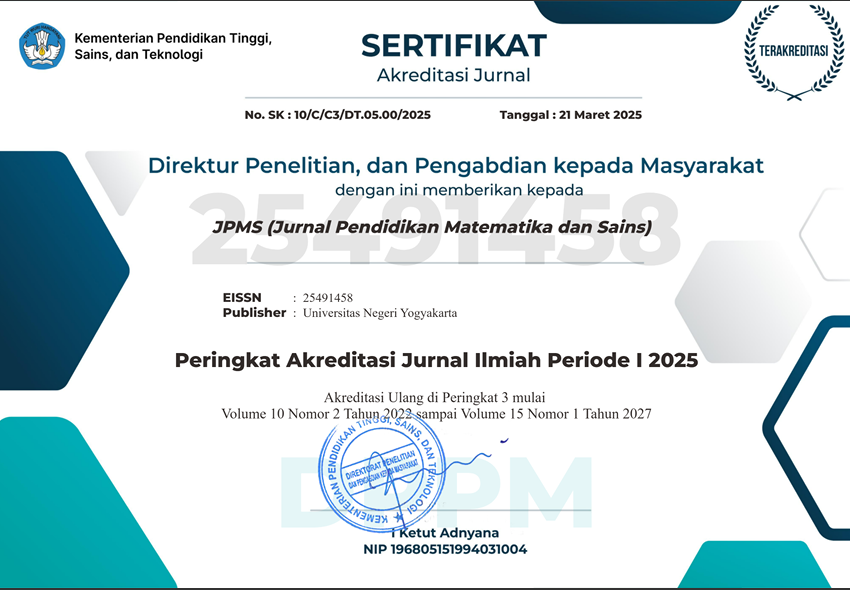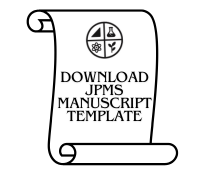Senior High School Students' Scientific Habits of Mind Profile on Chemical Equilibrium: Case of Health and Environmental Topics
DOI:
https://doi.org/10.21831/jpms.v12i1.74613Keywords:
Chemical Equilibrium, Environmental, Health, SHOMAbstract
References
Burgess, J. (2012). The impact of teaching thinking skills as habits of mind to young children with challenging behaviours. Emotional and Behavioural Difficulties, 17(1), 47-63. https://doi.org/10.1080/13632752.2012.652426
í‡alik, M., & Cobern, W. W. (2017). A cross-cultural study of ckcm efficacy in an undergraduate chemistry classroom. Chemistry Education Research and Practice, 18(4), 691-709. https://doi.org/10.1039/C7RP00016B
í‡alik, M., & Coll, R. (2012). Investigating socio-scientific issues via scientific habits of mind: Development and validation of the scientific habits of mind survey. International Journal of Science Education, 34(12), 1909-1930. doi: 10.1080/09500693.2012.685197
í‡alik, M., & KarataÅŸ, F. í–. (2019). Does a "Science, Technology and Social Change" course improve scientific habits of mind and attitudes towards socioscientific issues? Australian Journal of Teacher Education. https://doi.org/10.14221/ajte.2018v44n6.3
í‡alik, M., Turan, B., & Coll, R.K. (2014). A cross-age study of elementary prospective teachers' scientific habits of mind concerning socio-scientific issues. International Journal of Science and Mathematics Education, 12(6), 1315-1340. doi:10.1007/s10763-013-9458-0
Coll, R. K., Taylor, N., & Lay, M. C. (2009). Scientists' habits of mind as evidenced by the interaction between their science training and religious beliefs. International Journal of Science Education. https://doi.org/10.1080/09500690701762621
Creswell, J. C. (2012). Education research, planning, conducting, and evaluating quantitative and qualitative research.
Eny, H. A., & Wiyarsi, A. (2019). Students' chemical literacy on context-based learning: a case of equilibrium topic. Journal of Physics: Conference Series, 1397(1). https://doi.org/10.1088/1742-6596/1397/1/012035
Fadly, D., Rahayu, S., Dasna, I. W., & Yahmin, Y. (2022). The effectiveness of a soie-strategy using socio-scientific issues on students chemical literacy. International Journal of Instruction, 15(1), 237–258. https://doi.org/10.29333/iji.2022.15114a
Gauld, C.F., & Hukins, A. A. (1980). Scientific attitudes: a review. Studies in Science Education, 7, 129-161.
Gauld, C.F. (1982). The scientific attitude and science education: A critical reappraisal. Science Education, 66, 109–121.
Gauld, C.F. (2005). Habits of mind, scholarship and decision making in science and religion. Science & Education, 14, 291–308. http://dx.doi.org/10.1007/s11191-004-1997-x
Hayat, M. S., Rustaman, N. Y., Rahmat, A., & Redjeki, S. (2019). The improvement of prospective teachers' habits of mind during the 5E+e inquiry learning program in holticulture course. International Journal of Environmental & Science Education, 14(9), 535-545
Kousathana, M., & Tsaparlis, G. (2002). Students' errors in solving numerical chemical-equilibrium problems. Chemistry Education Research and Practice, 3(1), https://doi.org/10.1039/B0RP90030C
Lochmiller, C. R., & Lester, J. N. (2017). An introduction to educational research: connecting methods to practice
Marzano, R. J. (1994). Performance assessment on dimensions of learning. Alexandria, VA 22314: ACSD.
Noviyanto, T. S. H. (2021). Pengaruh rasa ingin tahu dan percaya diri terhadap kemampuan literasi sains siswa sekolah menengah atas di kota tangerang selatan. Jurnal Penelitian Sains Dan Pendidikan (JPSP), 1(2), 143–150. https://doi.org/10.23971/jpsp.v1i2.3109
Pratama, F.I., & Rohaeti, E. (2023). Students' chemical literacy ability on hydrocarbon material: a case of toxic compounds in fried food. Jurnal Penelitian Pendidikan IPA, 9(9), 6795–6802. https://doi.org/10.29303/jppipa.v9i9.4554
Prihastoto, R., Haryono, H., & Ashadi, A. (2019). Penerapan model pembelajaran learning cycle 5e untuk meningkatkan rasa ingin tahu dan prestasi belajar siswa pada materi kesetimbangan kimia kelas XI semester ganjil sma negeri 1 teras. Jurnal Pendidikan Kimia, 8(1), 110. https://doi.org/10.20961/jpkim.v8i1.22918
Sadhu, S., Ad'hiya, E., & Laksono, E. W. (2019). Exploring and comparing content validity and assumptions of modern theory of an integrated assessment: critical thinking-chemical literacy studies. Jurnal Pendidikan IPA Indonesia, 8(4), 570-581. DOI: 10.15294/jpii.v8i4.20967
Steinkuehler, C., & Duncan, S. (2008). Scientific habits of mind in virtual worlds. Journal of Science Education and Technology. https://doi.org/10.1007/s10956-008-9120-8
Tyson, L., Treagust, D.F., & Bucat, R. B. (1999). The complexity of teaching and learning chemical equilibrium. Journal of Chemical Education, https://doi.org/10.1021/ed076p554
Widoyoko, S.P. (2009). Evaluasi Program Pembelajaran.
Wiyarsi, A., & í‡alik, M. (2019). Revisiting the scientific habits of mind scale for socio-scientific issues in the Indonesian context, International Journal of Science Education, DOI: 10.1080/09500693.2019.1683912
Wiyarsi, A., Prodjosantoso, A. K., & Nugraheni, A. R. E. (2021). Promoting students' scientific habits of mind and chemical literacy using the context of socio-scientific issues on the inquiry learning. Frontiers in Education, 6(May), 1–12. https://doi.org/10.3389/feduc.2021.660495
Zeidler, D. L., Sadler, T. D., Simmons, M. L., & Howes, V. (2005). Beyond sts: a research-based framework for socioscientific issues education. Scince Education, 89(3), 357-372. https://doi.org/10.1002/sce.20048
Downloads
Published
How to Cite
Issue
Section
Citation Check
License
Jurnal Pendidikan Matematika dan Sains allows readers to read, download, copy, distribute, print, search, or link to its articles' full texts and allows readers to use them for any other lawful purpose. The journal allows the author(s) to hold the copyright without restrictions. Finally, the journal allows the author(s) to retain publishing rights without restrictions
- Authors are allowed to archive their submitted article in an open access repository
- Authors are allowed to archive the final published article in an open access repository with an acknowledgment of its initial publication in this journal

This work is licensed under a Creative Commons Attribution-ShareAlike 4.0 Generic License.





